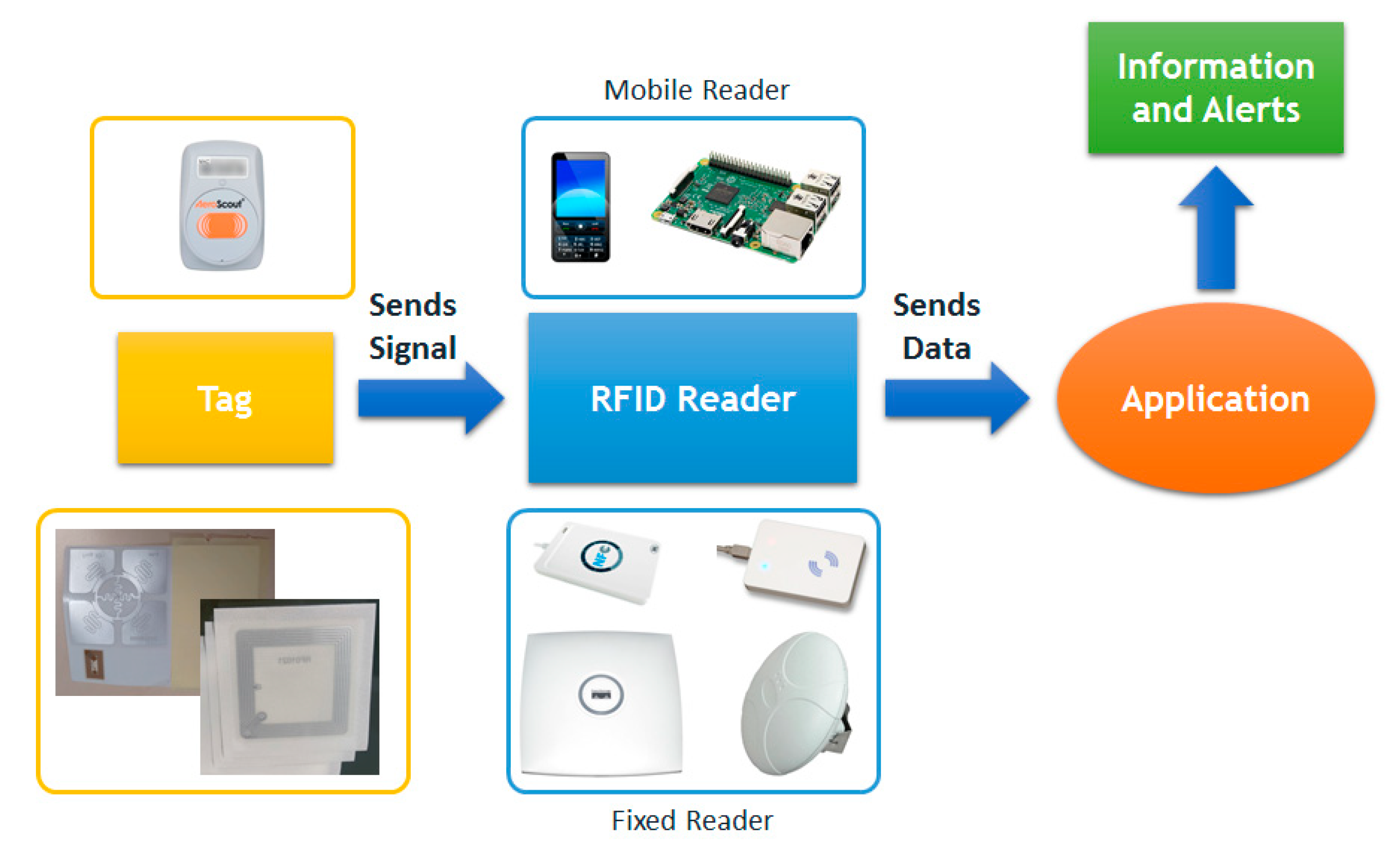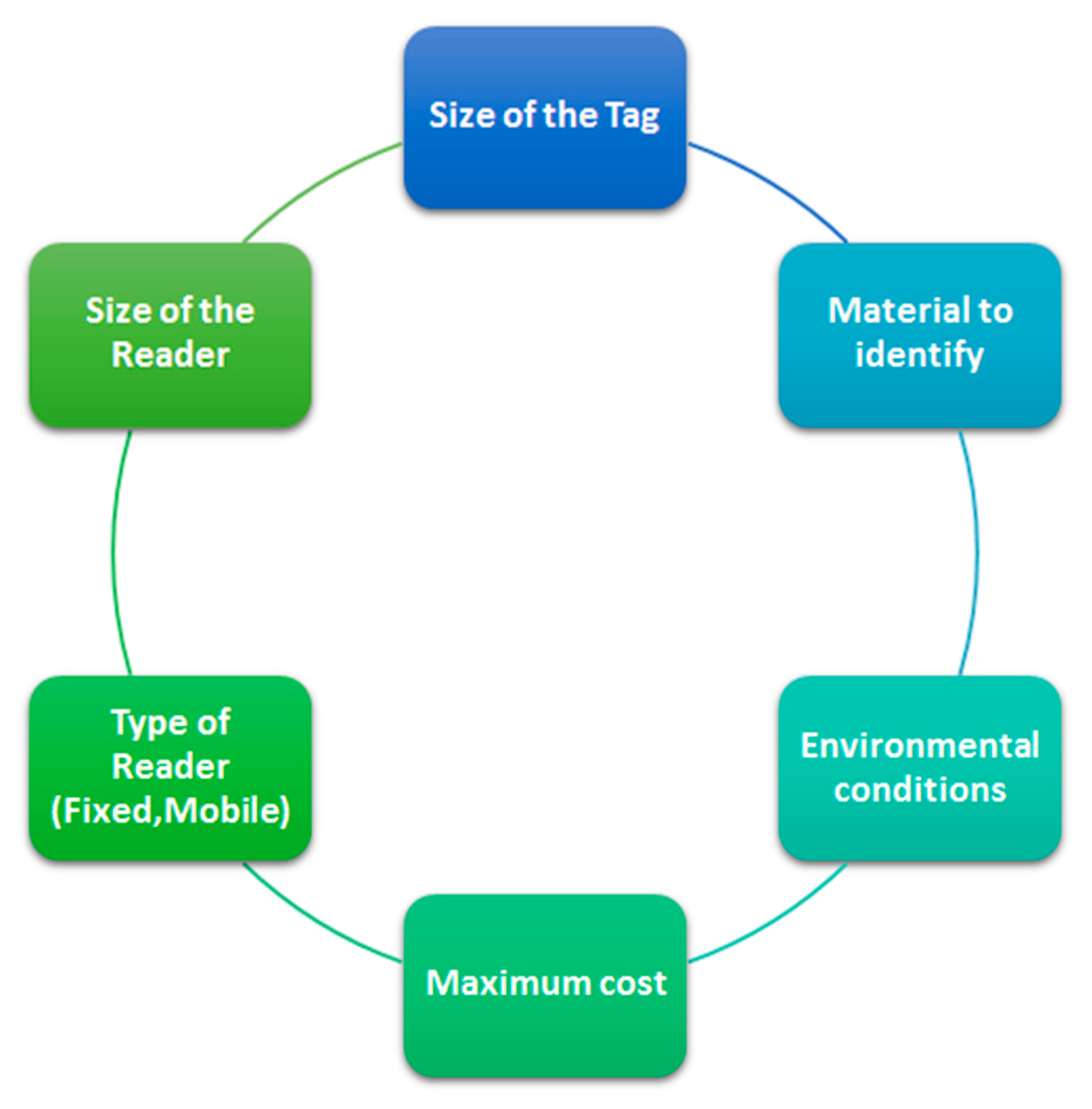The Integration of RFID Technology into Business Settings †
Abstract
:1. Introduction and Objectives
2. Results
- Tracking of products (medication, foodstuffs, organs, health products etc.); likewise the identification of transport and containers.
- Tracking of foodstuffs or gourmet products in cultivation or fishing, transport and subsequent sale and delivery (lot nº, expiry date, whereabouts, times, temperature, etc.)
- Tracking of luggage in airports: identification, check-in details, avoidance of theft or recovery of items
- Tracking of animals for identification, control of protected species or domestic animals
- Tracking of documents in any area. For example medical clinical histories
- Tracking of circuits/routes in conferences, car parks, businesses, museums, hospitals, cinemas, amusement parks
- Personalized mailing of information to users about tagged objects to their mobile devices
- Management of access to congresses, car parking sites, businesses, museums, cinemas, amusement parks, etc.
- Management of payments: for example shops and tollgates
- Management of loans and returns of documents, books, and multimedia etc. For example, in libraries
- Management of stocks and expiry dates: automatic inventory in real-time in shops and warehouses
3. Discussion and Conclusions
Author Contributions
Conflicts of Interest
References
- ISO 9000:2015; Sistemas de gestión de la calidad. Available online: https://www.iso.org/obp/ui/es/#iso:std:iso:9000:ed-4:v1:es (accessed on 25 June 2019).
- Osborn, S.; Williams, S. Seven steps to patient safety. In An Overview Guide for NHS Staff, 2nd ed.; The National Patient Safety Agency: London, UK, 2004. [Google Scholar]
- Martínez Pérez, M.; Cabrero-Canosa, M.; Hermida, J.V.; García, L.C.; Gómez, D.L.; González, G.V.; Herranz, I.M. Application of RFID technology in patient tracking and medication traceability in emergency care. J. Med. Syst. 2012, 36, 3983–3993. [Google Scholar] [CrossRef] [PubMed]
- Martínez Pérez, M.; Dafonte, C.; Gómez, Á. Traceability in Patient Healthcare through the Integration of RFID Technology in an ICU in a Hospital. Sensors 2018, 18, 1627. [Google Scholar] [CrossRef] [PubMed]
- Martínez Pérez, M.; Vázquez González, G.; Dafonte, C. Safety and Traceability in Patient Healthcare through the Integration of RFID Technology for Intravenous Mixtures in the Prescription-Validation-Elaboration-Dispensation-Administration Circuit to Day Hospital Patients. Sensors 2016, 16, 1188. [Google Scholar] [CrossRef] [PubMed]
- Martínez Pérez, M.; Vázquez González, G.; Dafonte, C. Evaluation of a Tracking System for Patients and Mixed Intravenous Medication Based on RFID Technology. Sensors 2016, 16, 2031. [Google Scholar] [CrossRef] [PubMed]
- Martínez Pérez, M.; Vázquez González, G.; Dafonte, C. The Development of an RFID Solution to Facilitate the Traceability of Patient and Pharmaceutical Data. Sensors 2017, 17, 2247. [Google Scholar] [CrossRef] [PubMed]




Publisher’s Note: MDPI stays neutral with regard to jurisdictional claims in published maps and institutional affiliations. |
© 2019 by the authors. Licensee MDPI, Basel, Switzerland. This article is an open access article distributed under the terms and conditions of the Creative Commons Attribution (CC BY) license (https://creativecommons.org/licenses/by/4.0/).
Share and Cite
Pérez, M.M.; Dafonte, C.; Gómez, Á. The Integration of RFID Technology into Business Settings. Proceedings 2019, 21, 6. https://doi.org/10.3390/proceedings2019021006
Pérez MM, Dafonte C, Gómez Á. The Integration of RFID Technology into Business Settings. Proceedings. 2019; 21(1):6. https://doi.org/10.3390/proceedings2019021006
Chicago/Turabian StylePérez, María Martínez, Carlos Dafonte, and Ángel Gómez. 2019. "The Integration of RFID Technology into Business Settings" Proceedings 21, no. 1: 6. https://doi.org/10.3390/proceedings2019021006
APA StylePérez, M. M., Dafonte, C., & Gómez, Á. (2019). The Integration of RFID Technology into Business Settings. Proceedings, 21(1), 6. https://doi.org/10.3390/proceedings2019021006





